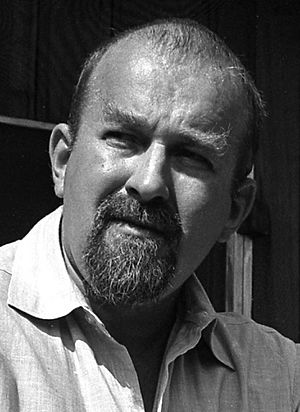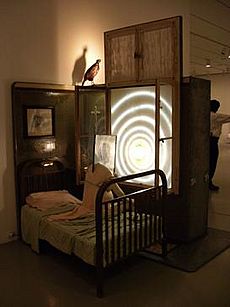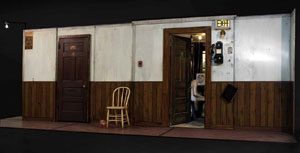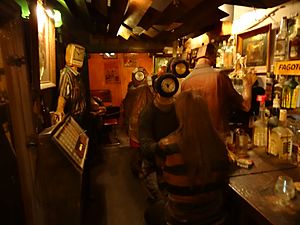Edward Kienholz facts for kids
Quick facts for kids
Edward Kienholz
|
|
|---|---|

Keinholz in 1965
|
|
| Born |
Edward Ralph Kienholz
October 23, 1927 |
| Died | June 10, 1994 (aged 66) Hope, Idaho, US
|
| Education | Eastern Washington College of Education Whitworth College "Self-taught" |
| Known for | Installation art Assemblage |
|
Notable work
|
Roxy's (1961) The Illegal Operation (1962) Back Seat Dodge ’38 (1964) The Wait (1964-65) The State Hospital (1966) Five Car Stud (1972) |
| Movement | Funk art |
| Awards | Guggenheim Fellowship (1976) |
Edward Ralph Kienholz (born October 23, 1927 – died June 10, 1994) was an American artist. He was known for creating "installation art" and "assemblage" sculptures. His art often showed strong opinions about modern life.
From 1972 onwards, he worked closely with his artistic partner and wife, Nancy Reddin Kienholz. Together, they created many artworks. For a long time, their art was more popular in Europe than in the United States. However, American museums have shown their work more often since the 1990s.
Contents
Early Life and Art Beginnings
Edward Ralph Kienholz grew up on a wheat farm in Fairfield, Washington. He learned useful skills like carpentry and mechanical work. He studied art briefly at Eastern Washington University and Whitworth College. But he did not get a formal degree.
After working many different jobs, Kienholz moved to Los Angeles. There, he became part of the exciting new art scene. In 1956, he opened the NOW Gallery. The next year, he helped open the Ferus Gallery. This gallery became a very important place for new and experimental art in Los Angeles.
Developing His Unique Art Style
Even without formal art training, Kienholz used his building skills to create art. He made "assemblages," which are artworks put together from different objects. He found these materials in alleys and on sidewalks. In 1958, he sold his share of the Ferus Gallery to focus on his own art. He started making large, room-sized artworks called "environmental tableaux" or "installations."
In 1961, Kienholz finished his first big installation, Roxy's. This artwork was a whole room that he showed at the Ferus Gallery. It later caused a lot of discussion at a big art show in Germany in 1968.
A show at the Los Angeles County Museum of Art (LACMA) in 1966 also caused a stir. His artwork, Back Seat Dodge ’38 (1964), was very controversial. People debated whether it should be shown. In the end, the museum agreed to show it with a rule: the car door would stay closed. It could only be opened by adults over 18, and only if no children were around. This made many people curious, and over 200 people lined up to see the artwork on opening day.
Around 1966, Kienholz started spending summers in Hope, Idaho. He also created "Concept Tableaux." These were framed texts that described artworks that didn't exist yet. He would sell these ideas. If someone paid more, Kienholz would actually build the artwork. Only one, The State Hospital, was fully built.
Kienholz's artworks often used "found objects"—things people had thrown away. He sometimes included figures made from casts of real people. His art was powerful and made viewers think about human life and challenges in society. He once said that looking through junk stores helped him understand a society.
Sometimes, Kienholz added radios or televisions to his works. This brought sound and moving images to his art. He even included live animals in some installations. For example, in The Wait, a sad scene about a lonely woman, there is a cage with a live parakeet. The bird's cheerful chirping and hopping made a strong contrast with the artwork's theme. Another famous work, The State Hospital, includes two black goldfish swimming in bowls. These bowls represent the heads of people suffering from mental illness.
Kienholz's art often commented on social issues. These included unfairness, growing older, mental health, poverty, and people not acting as they preach. Because his art often challenged common ideas, it was sometimes linked to the funk art movement.
Kienholz also valued a special artwork he found in a store window in Spokane, Washington. He called this found artwork The Jesus Corner. He showed it in museums and later made sure it was displayed in a museum he trusted in Missoula, Montana.
Working with Nancy Reddin

In 1981, Edward Kienholz announced that all his art made since 1972 should be seen as a collaboration with his wife, Nancy Reddin Kienholz. From then on, their work was signed by both of them as "Kienholz." Their art became very well-known, especially in Europe.
In the early 1970s, Kienholz worked in Berlin. Some of his important works from this time were based on old German radios from the 1930s and 40s. In 1973, he was a guest artist in Berlin.
In 1973, the Kienholzes moved from Los Angeles to Hope, Idaho. For the next twenty years, they split their time between Berlin and Idaho. In 1977, they opened "The Faith and Charity in Hope Gallery" at their Idaho studio. They showed art by both famous and new artists there. The Kienholzes also continued to create their own new installations and sculptures.
Edward Kienholz's Death
Edward Kienholz passed away suddenly in Idaho on June 10, 1994. He had a heart attack after hiking. He was buried in a very unique way, like one of his own art installations. His body was placed in the front seat of an old 1940 Packard car. He had a dollar, a deck of cards, and a bottle of wine with him. The ashes of his dog were in the back. His wife, Nancy Reddin Kienholz, steered the car into a large hole, like a funeral boat.
After Edward's death, Nancy Reddin Kienholz continued to manage their shared art. She organized shows and exhibitions until her own death in 2019.
Art Exhibitions
It has been difficult to organize large shows of Kienholz's work. This is because his sculptures and installations are often very large and fragile. They are also spread out in collections around the world.
For a long time, not many of his major works were shown in the United States. But American museums have started to feature their art more. A big show happened in 1996 at the Whitney Museum of American Art. Many museums in the US now own and display Kienholz's art. These include the Los Angeles County Museum of Art (LACMA) and the Smithsonian American Art Museum.
The different materials Kienholz used in his art can be a challenge for art experts. These experts, called "art conservators," work to keep the artworks looking as the artist intended. For example, caring for Back Seat Dodge '38 required special attention to preserve it.
In 2010, Kienholz's Roxy's (1960) was carefully rebuilt and shown in New York City. In 2011, his powerful 1972 installation Five Car Stud was reinstalled at LACMA. This artwork had been kept in storage for almost 40 years. It was later bought by the Prada Foundation. Kienholz's The Jesus Corner is now on display at the Museum of Arts and Culture in Spokane, Washington.
His Artistic Legacy
Edward Kienholz is seen as a pioneer in art. As early as 1960, with Roxy's, he was creating what became known as installation art and assemblage art. He also made early works of conceptual art in the mid-1960s. These were artworks based on ideas. Kienholz was aware of his important place in the art world. He worked to shape how people saw his art and his lasting impact.
See also
 In Spanish: Edward Kienholz para niños
In Spanish: Edward Kienholz para niños



